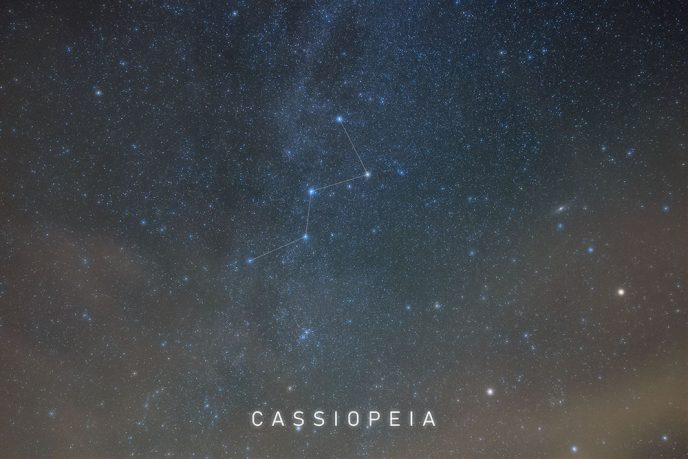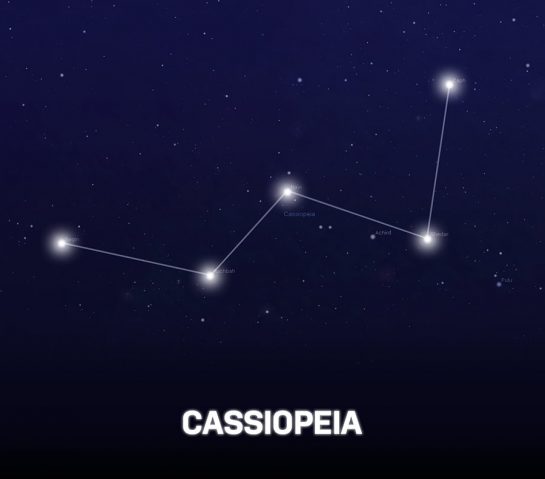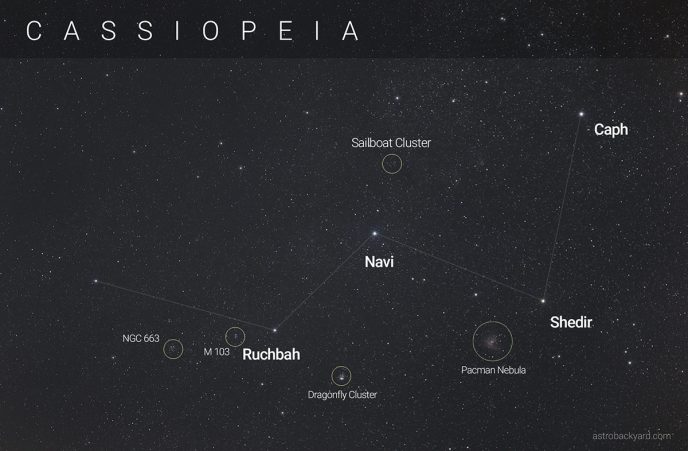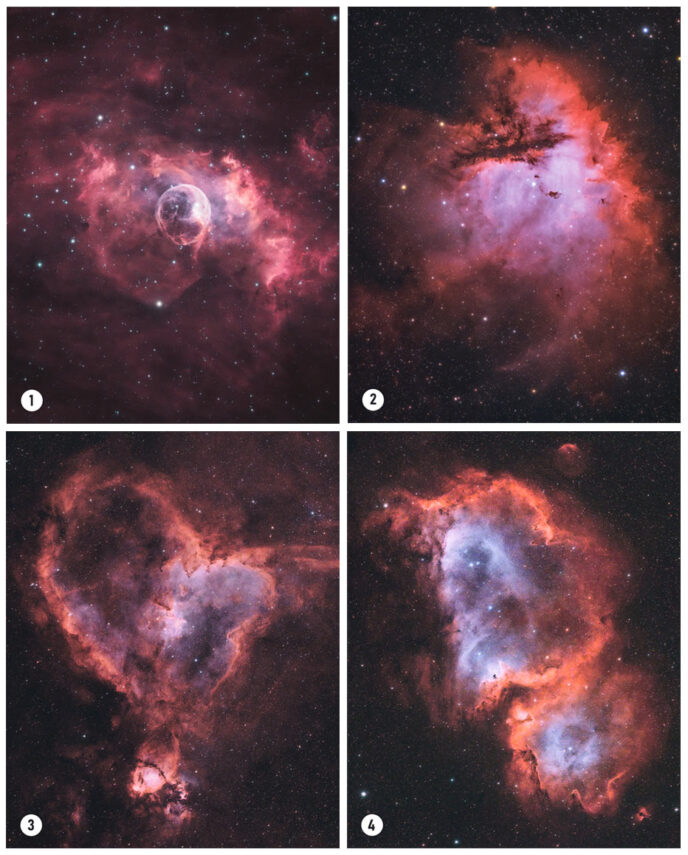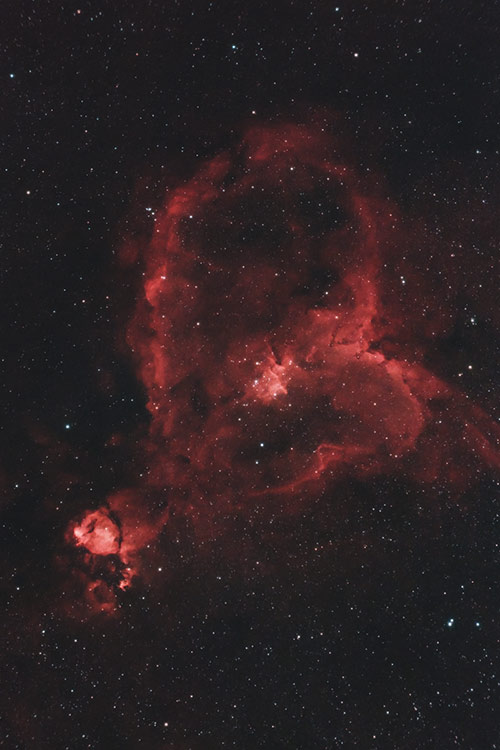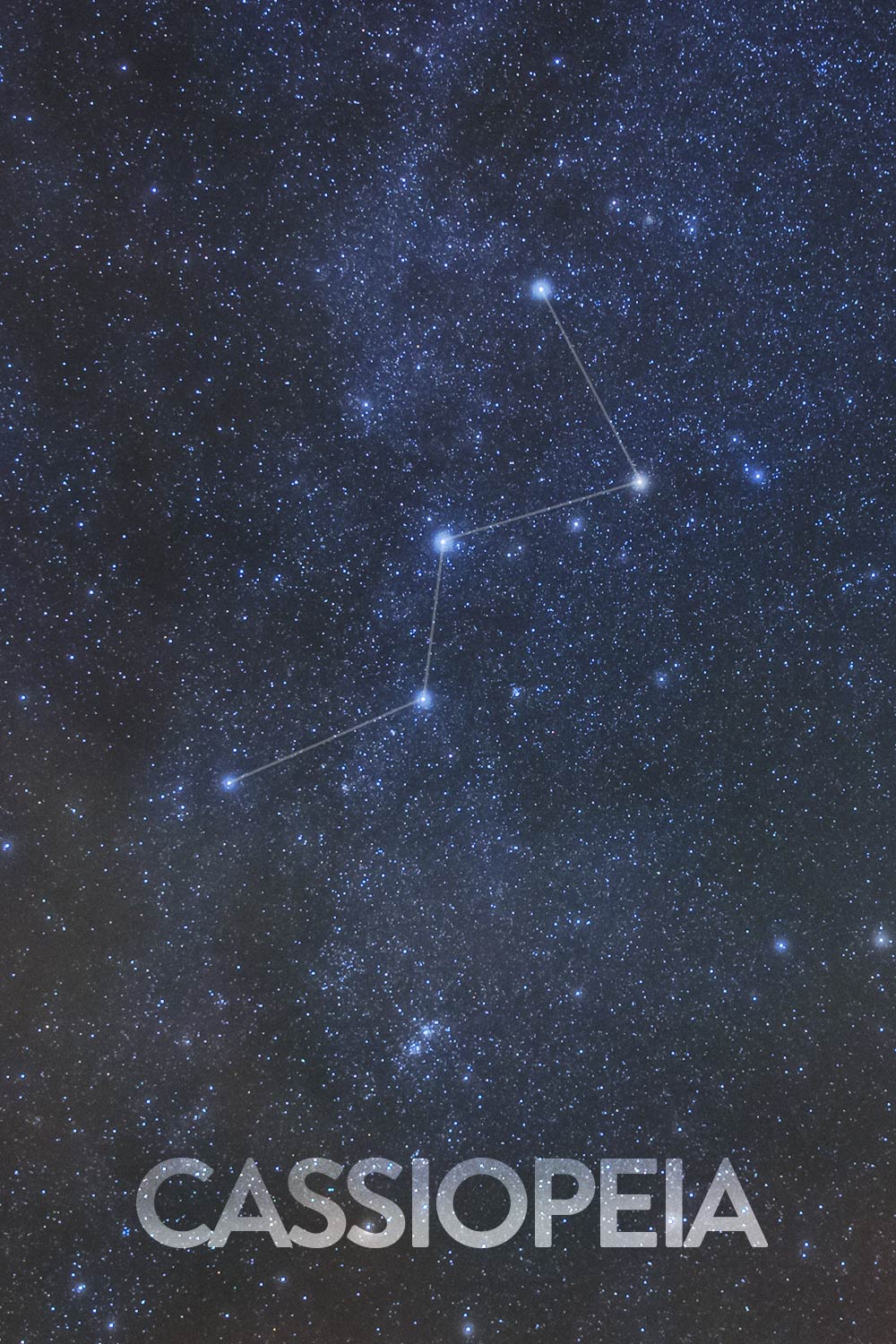The Constellation Cassiopeia
Cassiopeia is a constellation found in the northern sky. It was one of the 48 constellations listed by the 2nd-century Greek astronomer Ptolemy. Cassiopeia is one of the 88 modern constellations we see today.
It is famous for its distinctive “W” shape. This asterism is formed by five bright stars; Epsilon, Ruchbah (Delta), Gamma, Schedar (Alpha Cassiopeiae), and Caph (Beta Cassiopeiae).
The Cassiopeia constellation gets its name from the vain Queen Cassiopeia found in Greek Mythology. A section of the Milky Way runs through Cassiopeia, containing a number of open clusters, young luminous galactic disc stars, and nebulae.
Cassiopeia belongs to the Perseus family of constellations, along with Andromeda, Auriga, Cepheus, Cetus, Lacerta, Pegasus, Perseus, and Triangulum.
The “W” Shape of Cassiopeia in the night sky.
- Symbolism: The Seated Queen
- Brightest star: Schedar (α Cas)
- Declination: 77.6923447°–48.6632690°
- Genitive: Cassiopeiae
- Named Stars: Segin, Ruchbah, Navi, Schedar, Caph
- Common Names: Cassiopeia’s Chair, The Lady of the Chair, Celestial M, Lazy M
Cassiopeia’s Prominent Stars
The first star to the left in Cassiopeia is Epsilon Cassiopeiae (also called Segin). Epsilon Cassiopeiae is a hot bright blue-white giant. The surface temperatures on this star are approximately 15,680K. It is about 430 light-years away from our planet.
This star is 6.5 times massive than our sun and is 4.2 times wider. Segin belongs to a class of stars classified as B Stars. These types of stars spin rapidly causing them to emit a ring of matter.
Moving inward on the “W” shape and to the lower right of Epsilon Cassiopeiae is the star known as Ruchbah or also referred to as Delta Cassiopeiae. Ruchbah is an Algol-type eclipsing binary star.
It belongs to the spectral class A5. It is about 99 light-years distant from our planet. Ruchbah has a magnitude that can vary between 2.68 and 2.74. Ruchbah is the fourth brightest star in the Cassiopeia constellation. The star’s customary name, Ruchbah, comes from the Arabic rukbah, which means “the knee”.
Moving inwards to the middle of the asterism is the star referred to as Gamma Cassiopeiae (Navi). This star is the brightest star in the constellation. It is a blue star that is approximately 610 light-years distant from our planet. Gamma Cassiopeiae has a luminosity 40,000 times that of our Sun.
It exhibits irregular variations in brightness, which ranges between 2.20 magnitudes and 3.40 magnitudes. Gamma Cassiopeiae is an eruptive variable star. The star is a known X-ray source.
Gamma can emit 10 times higher the amounts of X-ray radiation than that of other B class stars. The Chinese call this star Tsih, translating to “the whip.” Gamma also has the nickname Navi, after the American astronaut Virgil Ivan Grissom.
This is because the star was used as a navigational reference point by astronauts. Navi is a Semordnilap name; Ivan spelled backward.
Schedar or also known as Alpha Cassiopeiae is the next star in Cassiopeia’s asterism. It is located at the bottom right of the W asterism. Schedar is an orange giant.
It is approximately 228 light-years distant from our sun. Its magnitude is in the range from 2.20 to 2.23 magnitudes. The star’s name Schedar is derived from the Arabic şadr, which translates to “breast.” The name refers to the star’s position, marking Cassiopeia’s heart.
The final star in the asterism is Caph or also called Beta Cassiopeiae. It is a giant star belonging to the spectral type F2. Caph is approximately 54.5 light-years from earth.
Caph has a magnitude of 2.27. Its traditional name is derived from the Arabic kaf, which means “palm” (i.e. palm of the Pleiades). The star’s other traditional names are al-Sanam al-Nakah and al-Kaff al-Khadib.
Star chart for the constellation Cassiopeia. Sky and Telescope and IAU.
Fainter Stars of Cassiopeia
There are several other fainter stars within this constellation that are not all visible to the naked eye. Eta Cassiopeiae is the nearest star in Cassiopeia to our solar system, only 19.4 light-years away. It is similar to our Sun, being a yellow-white G-class hydrogen fusing dwarf, slightly cooler than the Sun with a surface temperature of 5730 Kelvin. Eta Cassiopeiae has a magnitude of 3.45.
Another fainter star is Zeta Cassiopeiae. It is a blue-white subgiant, approximately 600 light-years distant from our solar system. Zeta Cassiopeiae has a magnitude of 3.67.
Rho Cassiopeiae belongs to a very rare class of stars, the yellow hypergiants. Only seven are currently known in the Milky Way Galaxy. This one is also located in the constellation Cassiopeia. It is approximately 11,650 light-years distant and one of the most luminous stars known.
This star is visible to the naked eye. V509 Cassiopeiae is another G-type hypergiant, within Cassiopeia. It is at least 7,800 light-years distant from our solar system. The yellow-white star is classified as a semi-regular variable. Its luminosity varies between magnitudes 4.75 and 5.5.
Deep Space Objects
There are several impressive deep-sky objects in the constellation Cassiopeia. Many of these objects are bright emission nebulae, which make great astrophotography targets for your camera and telescope.
The image below includes 4 of the most rewarding deep-sky objects in Cassiopeia to photograph (The Bubble Nebula, Pacman Nebula, Heart Nebula, and Soul Nebula).
Popular Deep-Sky Objects in Cassiopeia.
Messier 52 is an open cluster located in the Cassiopeia constellation. Messier 52 is approximately 5,000 light-years distant from our solar system. It has a magnitude of 5.0 and we can view it through binoculars.
The cluster is estimated to be around 35 million years old. It is 19 light-years in diameter. The cluster was discovered in 1774 by Charles Messier.
The brightest stars in this cluster are two yellow giants with magnitudes of 7.77 and 8.22.
The Bubble Nebula region in Cassiopeia.
Messier 103 is another open cluster in Cassiopeia. It lies approximately 10,000 light-years from Earth and contains 172 stars. The age of the cluster is estimated to be about 25 million years. The cluster was discovered by the French astronomer Pierre Méchain in 1781.
Cassiopeia A is a supernova remnant. It is notable for being the brightest astronomical radio source in the sky. It is the strongest radio source in the sky outside of our solar system. Cassiopeia was one of the first radio sources discovered, in 1947.
The cloud of material ejected in the explosion is roughly 10 light-years across. The material is expanding at a rate of 4,000-6,000 km/s. It has a temperature of about 50 million degrees Fahrenheit. The explosion of Cassiopeia A occurred at an estimated distance of 11,000 years from our planet. The first light of the supernova is believed to have reached Earth about 300 years ago.
The Pacman Nebula or NGC 281 is an H II region, a large gas cloud where a star formation has recently taken place. It contains a large amount of ionized atomic hydrogen (H II) which is lit by the ultraviolet light of young, hot, blue stars.
It was nicknamed the Pacman Nebula because of its likeness to the character from the popular arcade game. The nebula is 9,500 light-years from our planet. It was discovered by American astronomer E.E. Barnard in 1883.
The Pacman Nebula in Cassiopeia.
The White Rose Cluster or NGC 7789 is an open star cluster that is approximately 7,600 light-years distant from our solar system. It has a magnitude of 6.7.
This cluster was discovered by a British astronomer by the name of Caroline Herschel in 1783. The cluster is also known as Caroline’s Rose or The White Rose because of the loops the stars create. These loops resemble the pattern of rose petals.
Caldwell 18 or NGC 185 is a dwarf spheroidal galaxy. It is approximately 2.08 million light-years from our planet.
It has an active galactic nucleus (AGN). This galaxy was discovered by an English astronomer by the name John Herschel in 1787. It was first photographed by an American astronomer James Edward Keeler between 1898 and 1900. He photographed the galaxy using the Crossley telescope (36-inch/910mm), the reflecting telescope located at Lick Observatory in California.
Atypical for a dwarf elliptical galaxy, NGC 185 contains young clusters of stars and shows evidence of star formation that occurred in the cluster until recently.
Caldwell 17 or NGC 147 is another dwarf spheroidal galaxy in Cassiopeia. It is roughly 2.53 million light-years distant from the earth. It was originally discovered by John Herschel in 1829. This galaxy has a magnitude of 10.5.
The Heart Nebula or NGC 896, is about 7500 light-years away from our planet. It is located in the Perseus Arm of the Galaxy within the constellation Cassiopeia. This nebula was discovered by William Herschel in 1787. This nebula’s emissions show glowing ionized hydrogen gas as well as darker dust lanes.
The Heart Nebula (IC 1805)
The Soul Nebula or Westerhout 5 is an emission nebula that is located within Cassiopeia. There are several small open clusters that are embedded within this nebula. A more notable name for this nebula is IC 1848.
There is a meteor shower referred to as the December Phi Cassiopeiids that was recently discovered. These appear in early December, radiating from Cassiopeia. The Phi Cassiopeiids are very slow, with an entry velocity of approximately 16.7 kilometers per second. The shower’s parent body is believed to be a Jupiter family comet, though its specific identity is unknown.
The Soul Nebula (IC 1848)
Bordering on the constellation Cepehus, next door, the Lobster Claw Nebula (Sharpless 157) is a fascinating emission nebula with a distinctive shape. This nebula resides in a congested area of the night sky close to the Bubble Nebula and Cave Nebula in Cepheus.
Location
Cassiopeia is the 25th largest constellation in the night sky, occupying an area of 598 square degrees. It lies in the first quadrant of the northern hemisphere (NQ1) and can be seen at latitudes between +90° and -20°.
The neighboring constellations are Andromeda to the south, Perseus to the southeast, Camelopardalis to the east, Lacerta to the west, and Cepheus to the north. Cassiopeia is located close to the north celestial pole and it is completely below the horizon for anyone located south of -20 degrees.
The constellation of Cassiopeia is best visible when it is overhead, in the middle of a northern hemisphere night.
Its bright “W” of stars almost drowned in the Milky Way if we view it against a dark moonless sky. Cassiopeia is circumpolar from our latitudes so that it never dips below the horizon.
The Origins of Cassiopeia
The most renowned origin of Cassiopeia is from Greek mythology. In these myths, Cassiopeia was portrayed as a vain, self-absorbed queen. Cassiopeia was the wife of King Cepheus and mother of Andromeda.
Cassiopeia is represented as being chained to her throne in the heavens as punishment for her boast of being more beautiful than all the Nereids, the sea nymphs. As punishment, the god Poseidon placed Cassiopeia and Cepheus in the sky. Cassiopeia was condemned to circle the celestial pole forever.
As the stars rotate throughout the night, Cassiopeia can sometimes be seen hanging upside down as punishment for her vanity.
In the 1600s, various Biblical figures were depicted in the stars of Cassiopeia. These included Bathsheba, Solomon’s mother; Deborah, an Old Testament prophet; and Mary Magdalene, a disciple of Jesus.
An Arab constellation that incorporated the stars of Cassiopeia was the Camel. Its head was composed of Lambda, Kappa, Iota, and Phi Andromedae; its hump was Beta Cassiopeiae; its body was the rest of Cassiopeia, and the legs were composed of stars in Perseus and Andromeda.
A figure called the “Tinted Hand” also appeared in the stars of Cassiopeia in some Arab atlases. This is said to represent a woman’s hand-dyed red with henna, as well as the bloodied hand of Muhammad’s daughter Fatima.
In Persia, she was drawn by al-Sufi as a queen holding a staff with a crescent moon in her right hand, wearing a crown, as well as a two-humped camel.
In France, she was portrayed as having a marble throne and a palm leaf in her left hand, holding her robe in her right hand. This depiction is from Augustin Royer’s 1679 atlas.
In Chinese astronomy, the stars forming the constellation Cassiopeia are found among three areas: the Purple Forbidden enclosure (紫微垣, Zǐ Wēi Yuán), the Black Tortoise of the North (北方玄武, Běi Fāng Xuán Wǔ), and the White Tiger of the West (西方白虎, Xī Fāng Bái Hǔ).
The Chinese astronomers saw several figures in what is modern-day Cassiopeia. Kappa, Eta, and Mu Cassiopeiae formed a constellation called the Bridge of the Kings; when seen along with Alpha and Beta Cassiopeiae, they formed the great chariot Wang-Liang.
The charioteer’s whip was represented by Gamma Cassiopeiae, sometimes called “Tsih”, the Chinese word for “whip”.
Other cultures see a hand or moose antlers in the pattern. These include the Lapps, for whom the W of Cassiopeia forms an elk antler. The Chukchi of Siberia similarly saw the five main stars as five reindeer stags.
